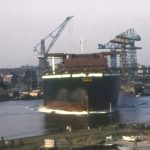1968 was an odd year for Mr Lawrence Stephen Lowry (1887 – 1976) and the painting Narcia fitting out at the Tyne held in the University of Salford Art Collection gives a tantalising glimpse into the rather unusual lifestyle of Salford’s great artist in his later years. It may not be the largest or most famous of his works, but the story it tells is a revealing one.
By 1968 Lowry had achieved the recognition he had long craved. His painting sales through various dealers were booming and yet in this year he announced his retirement. An article in the Sunday Times (14th April, 1968) reported his decision as “pretty strange” financially. As if profit is ever a true artist’s driving force and at 81 Lowry could be the most eccentric of true artists. Resident at ‘The Elms’ in Mottram-in-Longendale, Cheshire, he acknowledged his success with indifference, “Now I’m all right. I can sell the stuff. And the blighters won’t stop buying them, that’s the annoying thing.”¹
Wealth did not necessarily mean a comfortable retirement for Mr Lowry. When he was burgled in June, 1968, the thieves stole some of his paintings, but this too was met with indifference, he said the robbers had “no sense and less taste.”² The incident was the spur though for Lowry to have his first telephone installed, proof, if it were needed, that Lowry was a difficult man to reach on any level.
What money did allow Lowry to do was escape unseen to another world on the north east coast. Lowry loved Tyneside, “The Tyne is a very alive river” he declared, “with a lot of shipping on it and to watch the ships come in and go out keeps me out of mischief.”³ Specifically money meant that these trips could be made not on the train, where he might be recognised, but by taxi with only the driver to engage in conversation.⁴ Understandably Mr Lowry’s trade was much sought after by local taxi firms!
Lowry’s home-from-home in the North East was in Sunderland, the Seaburn Hotel, and his room of choice was number 104 with its view of the North Sea.⁵ Through the 1960s and 70s this was his regular haunt, though in 1968 the hotel’s name holds a little irony for Mr Lowry. From this base Lowry would visit Tyneside and watch in awe the ongoing construction of the huge ships as they were launched onto the river. “Some people like to go to the theatre, some people like to watch television, I just like watching ships.”⁶
The title of the University’s painting reveals Lowry’s interest in ship building. “Fitting out” would be done on the water after a ship was launched from dry dock. His fascination with ships and boats was ever present, his maritime works easily paralleling the industrial landscapes in number. It is quite possible that boats were some of the first things he drew and painted as a child. A pivotal boyhood memory was of being on a herring boat 75 miles out into the North Sea whilst his parents waited on shore for his return.⁷
On the Tyne there were leviathan vessels and the sense of wonder they instilled is so apparent with the Narcia. The large black ship dominates, but its oppressive presence is off-set by the colourful onlookers who float by in a little boat. Contrast these with the more familiar workaday trudge of the shipbuilders as they walk up the gang plank on the left, their stoop reminiscent of Lowry figures in more famous works such as Coming from the Mill (1930), held in The Lowry Collection at The Lowry, Salford. Through Lowry’s eyes we are looking at the stern of the ship, its two blade propeller is clearly visible on the waterline and there is a distinctive triangle on the hull above. These clearly defined elements and that descriptive title tell us that Lowry was painting from reality. The ship really existed and therefore it might be possible to find it. Often with research it’s all about finding the right direction to look in. The launch of such a large vessel would be documented and the largest ship yard on the Tyne in 1968 was Swan, Hunter and Wigham Richardson. In March, 1968 they launched an oil tanker for Deutsche Shell from the Wallsend dry dock.⁸ It would have been fitted out during the summer so Lowry could have seen it, in fact could have viewed it on more than one occasion during his stay in August. There is a problem though; the name of this vessel was the ‘Nacella’ not the ‘Narcia’. The photo below is compelling evidence that this is indeed the ship that Lowry painted (the funnel would have been added as part of fitting out). So why the mistake?
Note that Lowry doesn’t make the name clear in that triangle above the propeller; he’s not sure what it says. Now of course it’s quite possible that a dealer made a mistake over the title, but it’s equally possible Lowry himself misheard the name, a Geordie accent taking the emphasis off the double “L” sound. The two names are very similar.
So had Lowry retired from painting in 1968? Of course he hadn’t. He is still painting what he wants to paint. There’s a little hint of joy in that colourful boatload of onlookers. Contrast that with so many of his other paintings of large ships which appear as dark, lonely vessels on the open sea or entering harbours.
Mr Lowry was enjoying himself on Tyneside in August 1968. He was away from the prying eyes of the press, away from thieves and art dealers, doing just what he wanted. As sadly often happens such happiness can be brought to a sudden end. The following story appeared in the Yorkshire Post, 2nd September, 1968:
GUESTS FLEE FROM HOTEL BLAZE
A number of guests, including L S Lowry, 80, the artist, rushed from a blazing seaside hotel in their nightclothes early yesterday. The staff of the Seaburn Hotel, Sunderland, guided 63 guests across a car park to an annexe where they stayed for an hour while five fire engines fought a blaze in a ground floor lounge. Ambulances stood by as firemen wearing breathing apparatus searched rooms to make sure all the guests had left. Two visitors were overcome by smoke and taken to hospital for treatment. A hotel spokesman said “The fire was discovered by a night porter. The staff wakened all the guests and led them down smoke filled staircases to safety.” Mr Lowry, who lives at the hotel, left after the blaze. A hotel spokesman said “He often goes away for a day or two without leaving a forwarding address.”
I did say there was an irony in the hotel’s name in 1968. Lowry made his exit before the press arrived en masse, but the painting in the University’s collection is testament to the fact that, even at 81, he was still interpreting the real world in his own unique way. That dear reader is what all great artists do, they don’t really ever truly retire.
Notes
- LS Lowry a biography, Shelley Rohde. Lowry Press 3rd edition 1999. Page 390.
- LS Lowry a biography, Shelley Rohde. Lowry Press 3rd edition 1999. Page 395.
- LS Lowry a biography, Shelley Rohde. Lowry Press 3rd edition 1999. Page 397.
- LS Lowry a biography, Shelley Rohde. Lowry Press 3rd edition 1999. Page 395.
- Sunderland Echo, My chats with Lowry 27th February, 2015
- Label in the Lowry Gallery.
- LS Lowry a biography, Shelley Rohde. Lowry Press 3rd edition 1999. Page 49.
- The full specification from the Swan Hunter Register for the Nacella is below
| Name: | NACELLA |
| Type: | Tanker |
| Launched: | 28/03/1968 |
| Completed: | 11/1968 |
| Builder: | Swan, Hunter & Wigham Richardson Ltd |
| Yard: | Wallsend |
| Yard Number: | 2022 |
| Dimensions: | 60275grt, 42594nrt, 117156dwt, 869.1 x 138.0 x 48.9ft |
| Engines: | Oil engine, 2SA, Sulzer type, 9cyl (900 x 1550mm), 18000bhp |
| Engines by: | Wallsend Slipway & Engineering Co Ltd, Wallsend |
| Propulsion: | 1 x Screw, 14.5knots |
| Reg Number: | n/a |
| History: | |
| 11/1968 | Deutsche Shell AG, Hamburg |
| 1986 | Solena Shipping Co (Deutsche Shell Tanker GmbH), Monrovia |
| 03/09/1993 | Broken up |
| Comments: | 03/09/1993: Arrived at Chittagong for breaking up by Taher & Co |
Danny Morrell, October 2017

